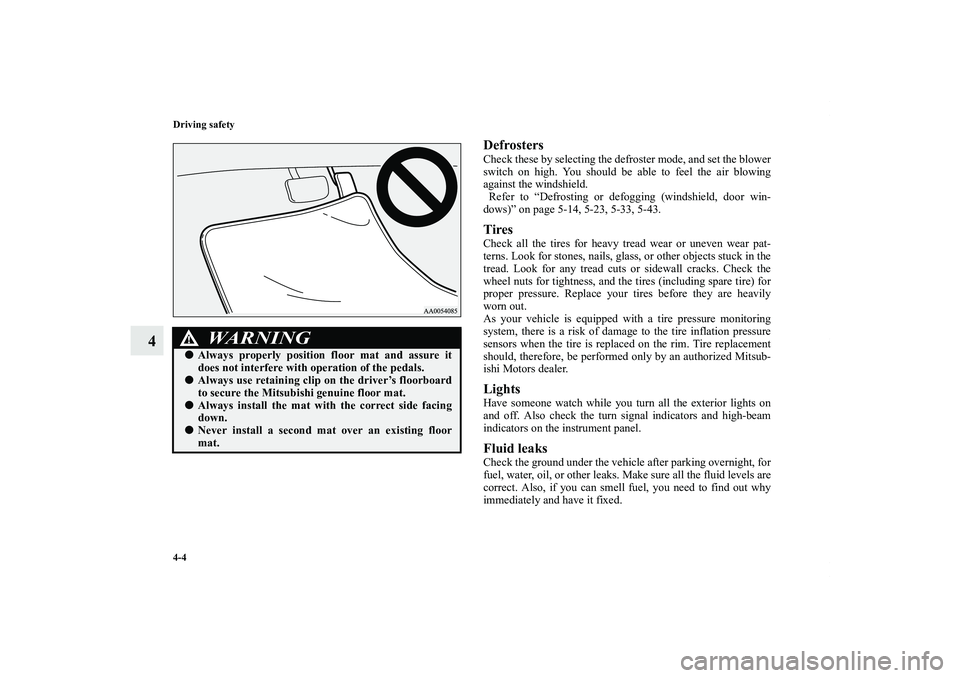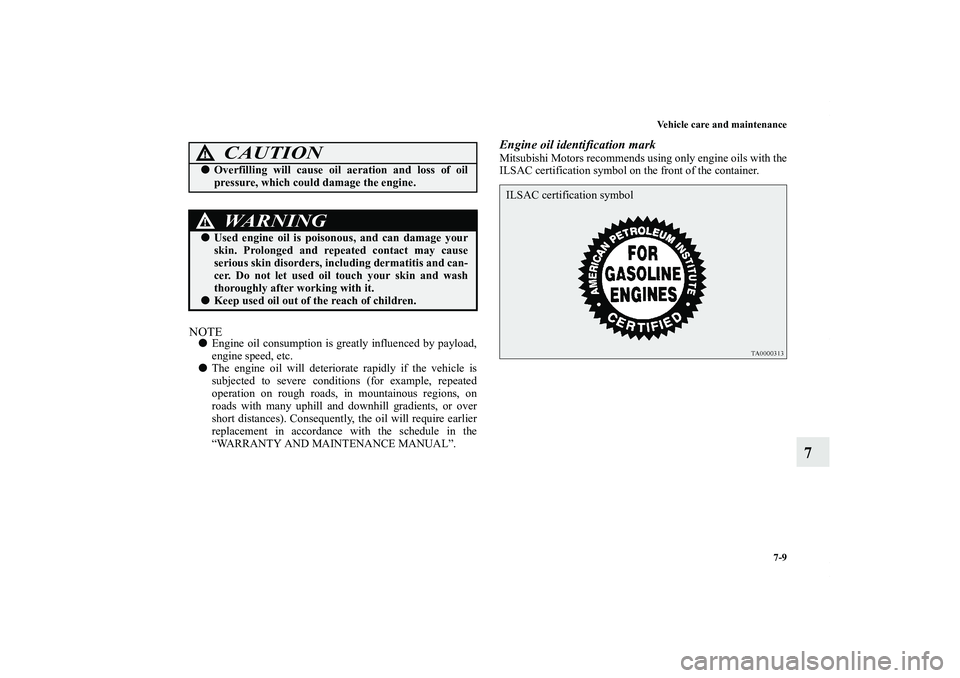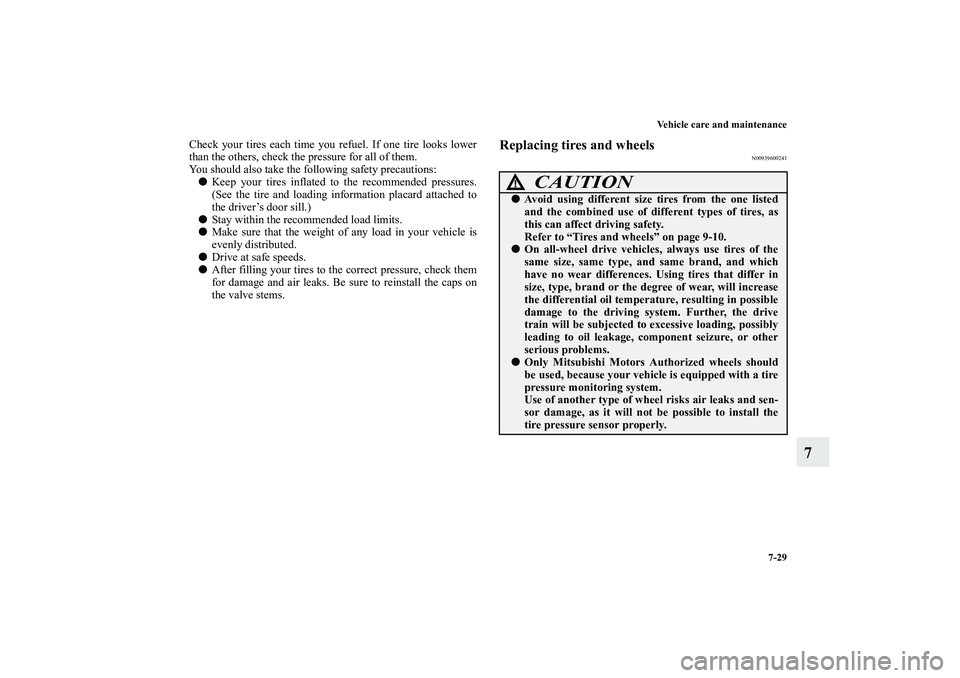Page 9 of 714
Overview
Changing tires P.6-10
Size of tires and wheels P.7-24
Tire inflation pressure P.7-28
Tire rotation P.7-31
Tire chains P.7-33
Tire pressure monitoring system
P.3-149 License plate light
P.3-212, 7-51, 7-73
Spare tire P.6-11F.A.S.T.-key (Free-hand Advanced Security
Transmitter) (if so equipped) P.3-16
Locking and unlocking P.3-53
Keyless entry sysetm (if so equipped) P.3-9, 3-45 High-mounted stop light
P.7-51, 7-75Antenna P.5-134
Rear window wiper
P. 3 - 2 3 0
Back-up light P.7-51, 7-70
Tail and stop light
P.3-212, 7-51, 7-68Turn signal lights
P.3-220, 7-51, 7-68 Rear spoiler
Rear side-marker lights
P.3-212, 7-51, 7-71Flap-fold tailgate P.3-60
Rear-view camera
(if so equipped)
P.3-155
BK0122500US.book 7 ページ 2010年5月12日 水曜日 午前11時11分
Page 240 of 714

Features and controls
3-125
3 Cautions on the handling of 4-wheel drive
vehicles
N00530800161
Tires and wheelsSince the driving torque can be applied to the four wheels, the
driving performance of the vehicle when operating in 4-wheel
drive is greatly affected by the condition of the tires.
Pay close attention to the tires.
�Install only the specified tires on all wheels. Refer to
“Tires and wheels” on page 9-10.
�Be sure all four tires and wheels are the same size and
type.
When it is necessary to replace any of the tires or wheels,
replace all four.
�All tires should be rotated before the wear difference
between the front and rear tires is recognizable.
Good vehicle performance cannot be expected if there is a dif-
ference in wear between tires. Refer to “Tire rotation” on page
7-31.
�Check the tire inflation pressure regularly.
CAUTION
!�Always use tires of the same size, type, and brand
that have no wear differences. Using tires of differ-
ent size, type, brands or degree of wear, will increase
the differential oil temperature and result in possi-
ble damage to the driving system. Further, the drive
train will be subject to excessive loading, possibly
leading to oil leakage, component seizure, or other
serious failures.
BK0122500US.book 125 ページ 2010年5月12日 水曜日 午前11時11分
Page 316 of 714

Features and controls
3-201
3
�There is a fault in the fuel system.�Contact an authorized Mitsubishi
Motors dealer or a repair facility of
your choice to have the system
checked.
�The vehicle is being driven with the
parking brake still applied.�Release the parking brake. Refer to
“Brake warning display” on page
3-209.
�There is a fault in the engine oil circu-
lation system.�Park your vehicle in a safe place as
soon as possible and contact an autho-
rized Mitsubishi Motors dealer or a
repair facility of your choice to have
the system checked.
Refer to “Oil pressure warning” on
page 3-211.
�There is a fault in the charging system.�Park your vehicle in a safe place as
soon as possible and contact an autho-
rized Mitsubishi Motors dealer or a
repair facility of your choice for assis-
tance.
Refer to “Charging system warning
light” on page 3-208.
�There is a fault in the SRS airbag or the
pre-tensioner system.�Contact an authorized Mitsubishi
Motors dealer or a repair facility of
your choice to have the system
checked.
Refer to “SRS airbag/Pre-tensioner
system warning” on page 2-70.
Screen type 1
Screen type 2
Cause
Do this (Reference)
BK0122500US.book 201 ページ 2010年5月12日 水曜日 午前11時11分
Page 326 of 714
Features and controls
3-211
3
Oil pressure warning display
N00558700087
Ty p e 1
Ty p e 2
If the engine oil pressure drops while the engine is running, the
warning display is displayed on the information screen in the
multi-information display.
NOTE�The oil pressure warning display does not show the
amount of oil. The oil level must be checked using the
dipstick.
CAUTION
!�If the vehicle is driven while the engine oil is low, or
the oil level is normal but the warning is displayed,
the engine may overheat and damage may result.�If the warning is displayed while the engine is run-
ning, park your vehicle in a safe place as soon as
possible and check the engine oil level.�If this warning display comes on when the engine oil
level is proper, have your vehicle checked at an
authorized Mitsubishi Motors dealer or a repair
facility of your choice.
BK0122500US.book 211 ページ 2010年5月12日 水曜日 午前11時11分
Page 407 of 714

4-4 Driving safety
4
DefrostersCheck these by selecting the defroster mode, and set the blower
switch on high. You should be able to feel the air blowing
against the windshield.
Refer to “Defrosting or defogging (windshield, door win-
dows)” on page 5-14, 5-23, 5-33, 5-43.TiresCheck all the tires for heavy tread wear or uneven wear pat-
terns. Look for stones, nails, glass, or other objects stuck in the
tread. Look for any tread cuts or sidewall cracks. Check the
wheel nuts for tightness, and the tires (including spare tire) for
proper pressure. Replace your tires before they are heavily
worn out.
As your vehicle is equipped with a tire pressure monitoring
system, there is a risk of damage to the tire inflation pressure
sensors when the tire is replaced on the rim. Tire replacement
should, therefore, be performed only by an authorized Mitsub-
ishi Motors dealer.LightsHave someone watch while you turn all the exterior lights on
and off. Also check the turn signal indicators and high-beam
indicators on the instrument panel.Fluid leaksCheck the ground under the vehicle after parking overnight, for
fuel, water, oil, or other leaks. Make sure all the fluid levels are
correct. Also, if you can smell fuel, you need to find out why
immediately and have it fixed.
WA R N I N G
!�Always properly position floor mat and assure it
does not interfere with operation of the pedals.�Always use retaining clip on the driver’s floorboard
to secure the Mitsubishi genuine floor mat.�Always install the mat with the correct side facing
down.�Never install a second mat over an existing floor
mat.
BK0122500US.book 4 ページ 2010年5月12日 水曜日 午前11時11分
Page 606 of 714

Vehicle care and maintenance
7-9
7
NOTE�Engine oil consumption is greatly influenced by payload,
engine speed, etc.
�The engine oil will deteriorate rapidly if the vehicle is
subjected to severe conditions (for example, repeated
operation on rough roads, in mountainous regions, on
roads with many uphill and downhill gradients, or over
short distances). Consequently, the oil will require earlier
replacement in accordance with the schedule in the
“WARRANTY AND MAINTENANCE MANUAL”.
Engine oil identification markMitsubishi Motors recommends using only engine oils with the
ILSAC certification symbol on the front of the container.
CAUTION
!�Overfilling will cause oil aeration and loss of oil
pressure, which could damage the engine.
WA R N I N G
!�Used engine oil is poisonous, and can damage your
skin. Prolonged and repeated contact may cause
serious skin disorders, including dermatitis and can-
cer. Do not let used oil touch your skin and wash
thoroughly after working with it.�Keep used oil out of the reach of children.
ILSAC certification symbol
BK0122500US.book 9 ページ 2010年5月12日 水曜日 午前11時11分
Page 608 of 714
Vehicle care and maintenance
7-11
7
3.0 L modelsSAE 5W-20 engine oil is strongly recommended for optimum
fuel economy and cold starting.
To replace the oil filterThe oil filter should be replaced at the time or mileage speci-
fied in the “WARRANTY AND MAINTENANCE MAN-
UAL”.
Only use high quality replacement filters on this vehicle. The
manufacturer’s specifications for Genuine Mitsubishi oil filters
require that the filter can withstand a pressure of 256 psi (1.8
MPa). A Genuine Mitsubishi oil filter is the best replacement
filter.
Follow the installation instructions printed on the filter.
BK0122500US.book 11 ページ 2010年5月12日 水曜日 午前11時11分
Page 626 of 714

Vehicle care and maintenance
7-29
7
Check your tires each time you refuel. If one tire looks lower
than the others, check the pressure for all of them.
You should also take the following safety precautions:
�Keep your tires inflated to the recommended pressures.
(See the tire and loading information placard attached to
the driver’s door sill.)
�Stay within the recommended load limits.
�Make sure that the weight of any load in your vehicle is
evenly distributed.
�Drive at safe speeds.
�After filling your tires to the correct pressure, check them
for damage and air leaks. Be sure to reinstall the caps on
the valve stems.
Replacing tires and wheels
N00939600241
CAUTION
!�Avoid using different size tires from the one listed
and the combined use of different types of tires, as
this can affect driving safety.
Refer to “Tires and wheels” on page 9-10.�On all-wheel drive vehicles, always use tires of the
same size, same type, and same brand, and which
have no wear differences. Using tires that differ in
size, type, brand or the degree of wear, will increase
the differential oil temperature, resulting in possible
damage to the driving system. Further, the drive
train will be subjected to excessive loading, possibly
leading to oil leakage, component seizure, or other
serious problems.�Only Mitsubishi Motors Authorized wheels should
be used, because your vehicle is equipped with a tire
pressure monitoring system.
Use of another type of wheel risks air leaks and sen-
sor damage, as it will not be possible to install the
tire pressure sensor properly.
BK0122500US.book 29 ページ 2010年5月12日 水曜日 午前11時11分